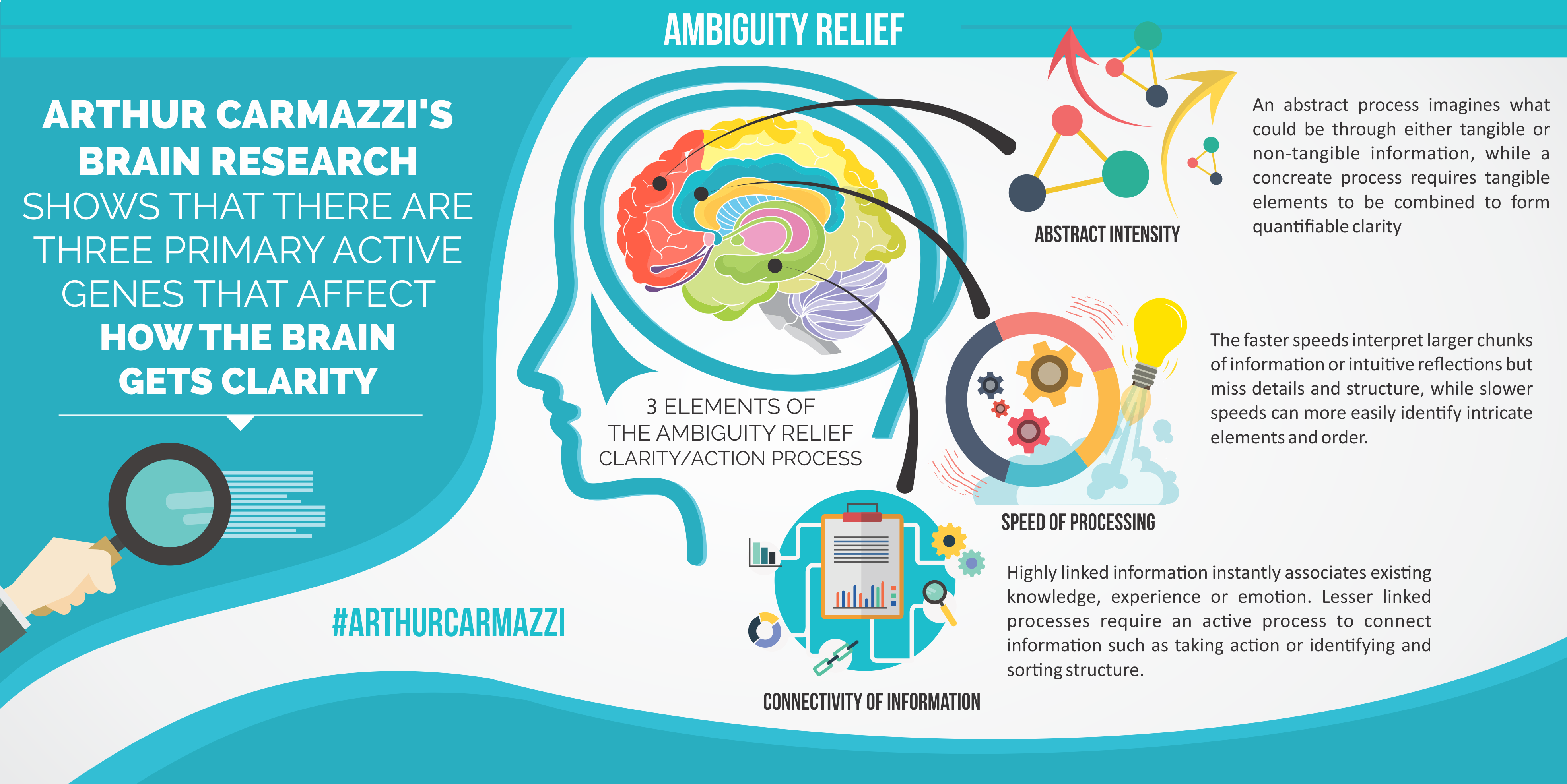“Ambiguity Relief” is the brain’s process that evaluates information to relate new context to existing knowledge, simplifying ideas, making decisions, and problem solving… and translates it into actionable elements. This is an essential element of communication and is directly related to action taking and to the attainment of clarity. Applications of this discovery can be applied to high-performance organizational culture change, leadership and management, marketing and improving relationships as well as getting people to take action.
A recent article in EC Neurology quoted me as:
According to Arthur Carmazzi, researcher and ranked as one of the world’s top 10 thought leaders in organizational culture and leadership, “This discovery is very important because All Decisions, Innovations, Idea Generation, Memory Retention, Interactions, and Interpretations… are filtered through the Brains Ambiguity Relief Process. The implications of identifying and understanding the brains ambiguity relief process will support improved communication, cooperation, synergy and how to move people passionately to action.”
The New brain research recently published in the Journal of Theranostics of Brain Disorders by Arthur Carmazzi, observed that most psychometric assessments either dealt with behavior or personality and too many variables not only affected accuracy, but also affected the ability to practically apply them. Identifying and studying these processes with over 7000 participants isolated four primary processes out of nine that are most common in mentally healthy individuals. Additional observations of children between the ages of 5 and 6 years old, revealed that these processes are visible even at early stages of development and they are genetic.
Further investigation of the neurochemistry behind the Ambiguity Relief processes appeared in the Prefrontal Cortex, the Hippocampus, and the Cingulate Cortex with three primary active genes that regulated Speed of processing, connectivity of information, and whether information is connected from external or internal stimulus which affects the amounts of structure and detail required for the ambiguity relief clarity getting process as well as intuitive or abstract processes. Highly linked information instantly associates existing knowledge, experience or emotion. Lesser linked processes require an active process to connect information such as taking action or identifying and sorting structure. The faster speeds interpret larger chunks of information or intuitive reflections but miss details and structure, while slower speeds can more easily identify intricate elements and order.
According to Arthur Carmazzi, “Awareness of these brain processes, and the fact that they are genetic and cannot be changed, helps team members adopt a “Cooperation” attitude instead of trying to change people according to your own process… which creates frustration on both sides”
The research concludes that personality is a complicated array of nurture and nature, but when we faced with a decision, a problem, an idea or a task, the brain must first go through a unique, genetically founded clarity getting process of “Ambiguity Relief” to competently achieve, formulate, or solve anything.
Carmazzi has created the classification of the four healthy brain processes simplifies it through the “Colored Brain” model. Misunderstandings often arise from misunderstanding a person’s “processes” towards objectives or goals and prevent getting everyone speaking the same language… The Colored Brain model is designed to support the reduction of barriers to create EASIER, FASTER and MORE EFFECTIVE communication across any group or relationship…
The four Ambiguity relief processes identified in the research are:
Chaotic Processing (Green Brain)
Must take some kind of action to get clarity and clarity is directly related to the revelations from their actions. They shape and reshape ideas, solutions in the process of acting on issues and get others involved and ask for feedback.
Linear Processing (Red Brain)
Needs Structure to achieve clarity, time to action is dependent on the available structure and the speed at which clarity is achieved. They connect tangible elements with logic, organize information into chunks and cross-reference to understand.
Relational Processing (Purple Brain)
Gets clarity by evaluating options, and needs abundant information to get clear options , time to action is contingent upon the extraction of substantial details relating to the issue. All information and experience is related and is reinforced by the amounts of information for each reference.
Intuitive Processing (Blue Brain)
Achieves clarity through reflection and intuitive referencing of past experiences, time to action is swift but regulated by a consistent assimilation of the surroundings and their experience. All information and experience is connected on an emotional level (it must be clarified that there was no specific pattern that showed that subjects were “Emotional”) in relation to them and their experiences.
The biggest reason that psychometric tools do not work is because they are too complicated, trying to be all to everyone. The result is usually that only the HR manager really understand and “possibly” uses them. Simplicity is the key to implementation. By focusing only on one factor of perception: Ambiguity Relief”, anyone regardless of the level can easily understand, remember and apply their awareness to manage their own expectations and set others up for success instead of failure.
The Colored Brain system has been designed specifically to achieve this by an interactive system that includes all team members in the awareness process by gamifying what happens after a person takes the test. The system helps team members not only to see what the processes of their colleagues are, but give insights and tips on miscommunication and how to prevent and solve it. The system goes one step further to give specific instructions on how a user would lead, inspire productivity, or improve relationships with others in their group.
This article is a summary of the original research:
OBSERVATION AND GENETIC FOUNDATIONS OF THE BRAIN’S “AMBIGUITY RELIEF” PROCESSES by
This article was written by Arthur Carmazzi: researcher, bestselling author, and currently ranked as one of the world’s top 10 thought leaders in organizational culture and leadership.


